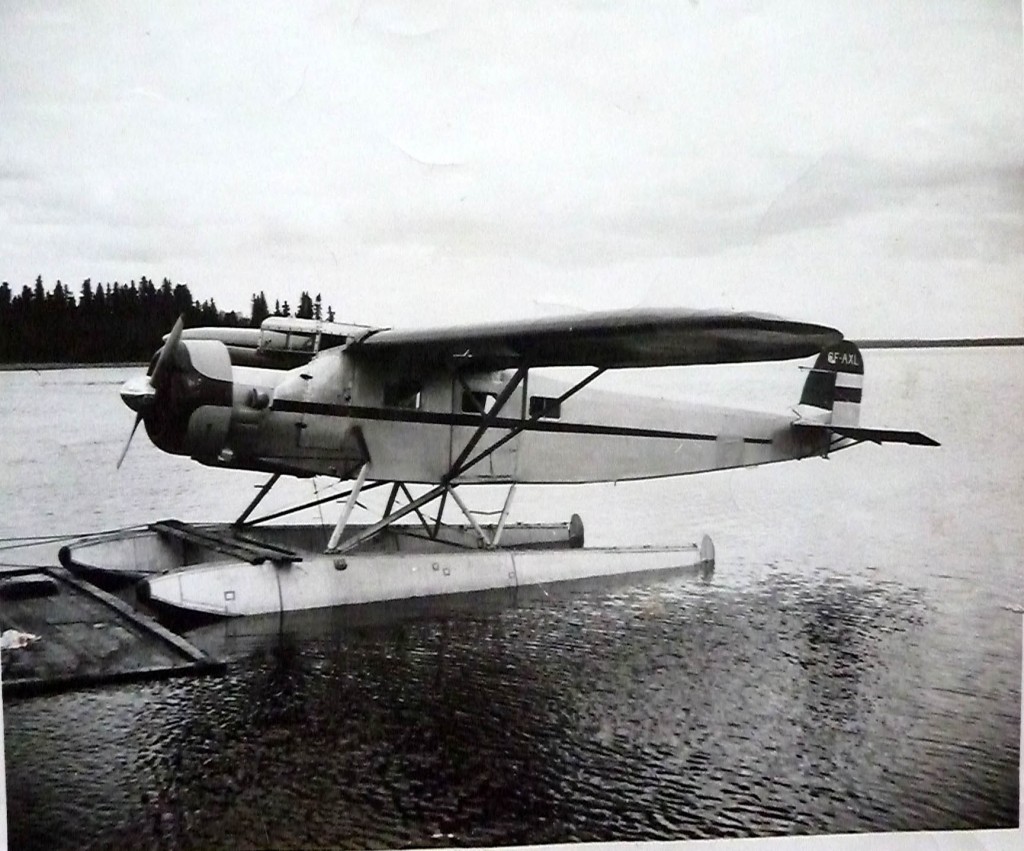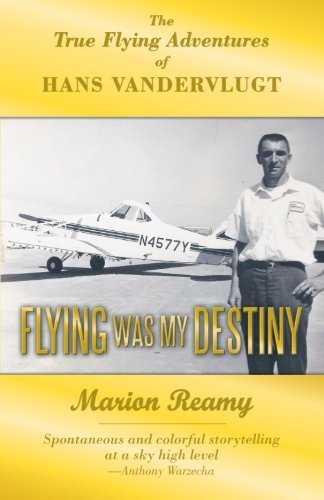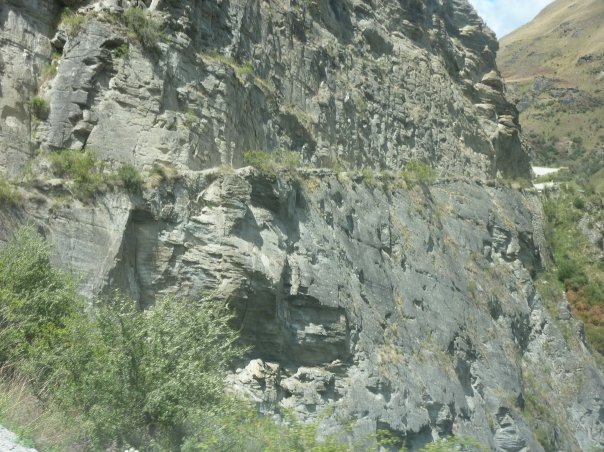Who’s Accountable to Whom?
The following is reprinted from an article written by Michael Byers and appearing in The Tyee on January 26, 2012.
I reprint the sections in which the author Michael Myers discusses with a German colleague the Canadian Parliamentary system vis a vis that of the German Reichstag. For the full article link here:
A View from the Reichstag: Who’s Accountable to Whom?
During a coffee break, a constitutional law professor quizzed me about Canada: “Is it true that your government has been shutting down Parliament?”
“Only temporarily,” I replied, explaining that Canadian prime ministers are entitled to ask the Governor General to prorogue Parliament. Stephen Harper first did so in Dec. 2008, in order to avoid losing a fiscal vote and thus his government. He did so again in Dec. 2009, in order to avoid parliamentary scrutiny of documents relating to the practice of transferring detainees to possible torture in Afghanistan. In both instances, the Governor General granted his request.
Nevertheless, Harper’s actions caused concern at home and abroad. As The Economist magazine observed on the second occasion, “The danger in allowing the prime minister to end discussion any time he chooses is that it makes Parliament accountable to him rather than the other way around.”
 My German colleague seemed to share that view: “Didn’t the Canadian Parliament respond by declaring the government in contempt?”
My German colleague seemed to share that view: “Didn’t the Canadian Parliament respond by declaring the government in contempt?”
“Not exactly,” I replied. The contempt of parliament ruling came later, in March 2011, after the government refused to provide MPs with detailed cost estimates for its crime bills. And while no other government in the Commonwealth had ever been found in contempt, Harper cavalierly downplayed the importance of the ruling, saying: “You win some, you lose some.”
Indeed, his Conservatives won a majority in the election that followed, which suggests that most Canadians were not particularly bothered by the finding of contempt.
“The real surprise,” I explained, “is that Harper does not appear satisfied with the extensive powers that are normally available to a majority government.”
I tell my German colleague about the government’s practice of invoking closure, with a frequency never before seen in Canada, to prevent elected MPs from debating major legislation such as the omnibus crime bill and a bill that will add dozens of new seats to the Commons.
About how, increasingly, the government moves the business of parliamentary committees behind closed doors, so that it can conceal embarrassing documents and reject witnesses proposed by opposition parties without fear of public censure.
Warning, with a smile
Finally, I explain how the Federal Court ruled in Dec. 2011 that a bill to abolish the Canadian Wheat Board was illegal because it violated a statutory requirement to poll wheat farmers first. No matter: the government adopted the bill anyway.
This led Peter Russell, the doyen of Canadian constitutional law, to warn: “Canadians should understand that at stake here is not just a technical point of law, but the integrity of parliamentary government.”
At this point, a wry smile crosses the German professor’s face.
“Professor Russell is right,” he says. “It’s all about understanding. Here in Germany, we sometimes learn our lessons too late.
While we are certainly no where near being turned into a dictatorship and the current government could fall (and will likely fall) in the next election, it is possible that several precedents will have been set by the current government that will be hard to dismantle.
We should all be concerned when any of our governing parties choose to disregard the building blocks of our parliamentary system.
For Prime Minister Harper and the Conservatives, far to many blocks are being pulled from the foundation.
Harold McNeill
Reference: Who’s Accountable to Whom?
(658)
Fairchild 82: A Northern Work Horse
Above Photo (Family Archives): CF-AXL moored at a makeshift dock on Touchwood Lake, northeast of LacLaBiche (c1961). The photo was taken on a trip made by Hans Vanderflugt (my instructor) and I while flying out of Cold Lake, AB in the late 50’s and early 60’s.
Photo Below: Hans and Ruth Vanderflugt
(that photo has somehow delinked from the story)
February 20, 2012. After posting this story on February 2, 2012, a young man, Daniel Mahoney, of Vanair Aviation, in Refugio, Texas, happened to pick it up the link off the Web while searching for background on his stepfather Hans. Dan phoned to tell me, Hans Vanderflugt, co-owner of Vanair, had just been killed in a crash near Colorado a few days before I posted the story (more information in the footer).
This story is dedicated to the memory of Hans, who is survived by his wife, Ruth Hodge Vandervlugt of Refugio, Texas; one son, John Vandervlugt of Round Rock, Texas; one stepson, Billy Michelson of San Antonio, Texas; and a sister, Erna Fentener Van Vlissingen of Amsterdam, Holland.
The following book was recently published about the heroic flying adventures of Hans as he tavelled the world delivering sngle and twin engine aeroplanes.
Photo of Hans Vandervlugt (October 2011) on the book cover.
(Note: I misspelt the surname in the original post as that is what I had always listed in my log book.)
1. Bush Flying in Northern Canada
At 6:00 am, I was out of bed and heading to the dock on Beaver Lake, about four miles east of LacLaBiche, Alberta, where Axle, the nickname for the Fairchild 82A, CF-AXL, was moored. The aircraft was one of the final two members of the Fairchild Series1 of bush planes built in the 1930s by Fairchild Aircraft Ltd. Canada, and still in service. Although not slick or fast, it was a workhorse in which we could haul up to 2000 lbs depending on how much fuel we had to carry.
On shorter trips (thirty to forty-five minutes) we only carried sufficient fuel for one or two round trips as each pound of fuel meant a pound less cargo. This particular aircraft had travelled to almost every corner of Northern Central and Western Canada, whereever pioneers were working to access the vast array of natural resources hidden among the millions of acres of wilderness rocks, trees, shrubs and thousands of freshwater lakes, rivers and streams that defined the north.
Production of the 82A was discontinued when the factory switched to cargo supply and bomber aircraft needed to help fight the Second World War. The Bristol Bolingbroke and the C-19 Packard were the most recognized aircraft being poured out of the Fairchild Factory in the 1940s. Unfortunately, the production of the 82A series was never resumed as the plans and molds were inadvertently destroyed during the company’s transition to wartime aircraft.
CF-AXL, the aircraft we flew back in the 1950’s and 60’s, currently resides in the Canadian Aviation and Space Museum in Ottawa. It was refurbished and moved to the museum in the 1960’s shortly after we flew it when working for a company owned by the father of a High School friend, Aaron Pinsky (lead photo in the link – top left (Aaron), bottom centre (Harold and Aaron, two cool dudes). We completed our flying training at RCAF Station Cold Lake and regularly flew together during the early years.
2. Early Mornings
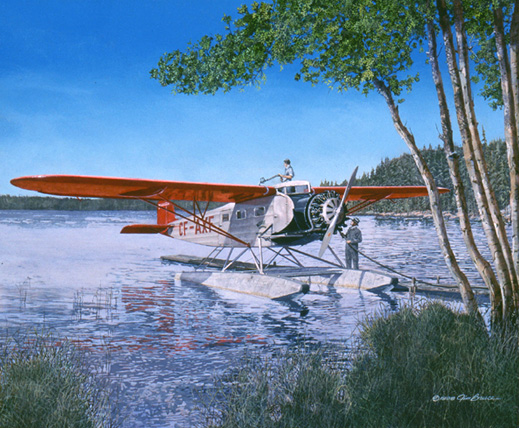 On this morning I was suffering a bit of a headache after hanging out a little too late with friends, the Gatzke’s, with whom I lived while attending grade five in LacLaBiche some ten years earlier (Link). On other flights, I had also made friends with several others who put me up while on layovers in LacLaBiche.
On this morning I was suffering a bit of a headache after hanging out a little too late with friends, the Gatzke’s, with whom I lived while attending grade five in LacLaBiche some ten years earlier (Link). On other flights, I had also made friends with several others who put me up while on layovers in LacLaBiche.
Photo (Painting of AXE by Jim Bruce, Aviation Artists, Web Source): This, the only other 82A in service in Canada, is shown being refuelled while moored to a small dock somewhere in Northern Canada. AXE disappeared in 1964 while on a flight in the Northern Arctic. Link to the story. Note the slide back access to the upper wing from the cockpit. That little door made accessing the fuel tanks much easier (there is also another photo attached to end of story). I can still remember the distinct smell of aviation fuel as we added fuel two or three times a day. We never carried more fuel than necessary as the weight of every extra gallon of fuel had to be subtracted from cargo.
By 6:30 Hans Vanderflugt, the Chief Pilot for Alberta Fish Products and I, had pumped the floats and topped up the gas, both accomplished with an ‘arm killer’ toggle pumps. Well, stating it was ‘Hans and I’ was generous as he usually let me do the toggle work while he held the hose. I never complained though as I was more than happy to be getting ‘free’ flying lessons as I built hours towards my Commercial Licence. If I had to do a little pumping, then fly twenty minutes, load 2000 pounds of fish, fly another twenty and unload it, it was a small price to pay for this kind of flying time.
Once I had completed the external and internal checks, then started the engine, Hans would cast off, jump into the co-pilots seat. We would taxi into the bay for our first flight of the day. Today, however, was to be different.
(5762)
Christchurch: The Gateway to Antarctica
Following in the footsteps outlined in Shackleton’s Forgotten Expedition, Lynn takes the controls as we head north along McMurdo Sound toward our Winter Quarters below Mount Erebus.
Five weeks and 5000 kilometers later, the final countdown for our time in New Zealand has finally arrived. We would have liked to stay longer but, due to a ticketing problem in our planned departure from Sidney Australia, we had to take a defined departure date. To make a change at this late date would have been far to expensive.
Our last few days are spent traveling up the East Coast from Invercargill through Dunedin where we visit the Lloyd family (Kim, the oldest daughter of our friends, David and Gill, and Kim’s husband Hywel and their two children – pictured in Rotorua story). After a short, but wonderful visit, we again head north along the coast toward Christchurch, making several stops along the way.
In scanning the slideshow you will note a group of amazing rocks, the Moeraki Boulders that look like giant cannonballs. Located at Koekohe Beach along a short stretch of the Otago coast, these boulders were formed millions of years ago in the Pleistocene era and only after millions of years of erosion have they made a surface appearance. Each decade more rocks have become exposed and it appears this is the only area in the world where these unique rocks can be found.
(296)
New Zealand: Invercargill
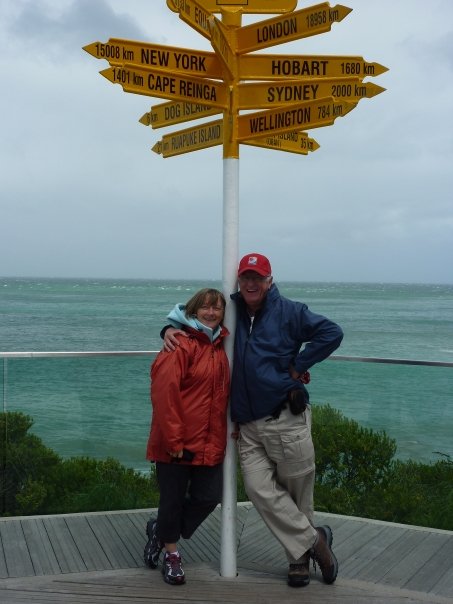
South Tip of the South Island
While in Switzerland, Lynn and I struck up a friendship with Karen and Nobby, a couple who hailed from Invercargill — the very southern tip of the South Island of New Zealand (next stop Antarctica). Some weeks after the meeting in Switzerland, and just by pure chance, we ran into Karen and Nobby again in Venice, totally unplanned, in the midst of a crowd that must have numbered in the hundreds of thousands. Can you imagine the coincidence?
Meant to be we figured and that we had best accept their invitation to visit their plantation in New Zealand! Well, that future came much sooner than expected when Lynn and I made the trek to Invercargill in late November, 2009.
So where does one start to tell the story of our visit with Nobby and Karen? Well, I suppose, I will do what Nobby would do in such a situation – just “tell it as you see it”. At one moment, Nobby is overwhelming a conversation with some witticism and the next he is in an engaging in conversation that demonstrates a wide knowledge of the world and of many interesting subjects.
(515)
Gisborne, New Zealand: Living Your Dream
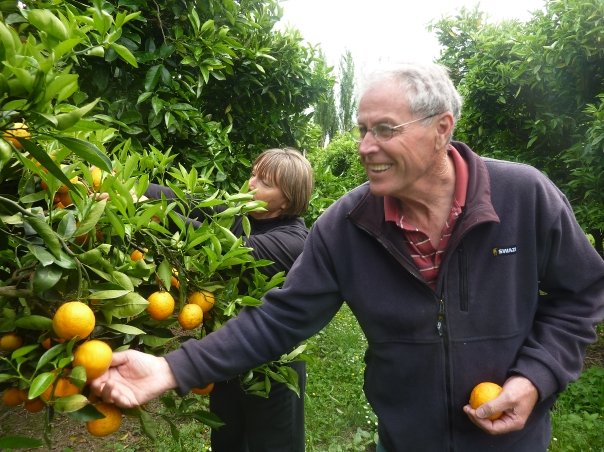
While in Rotorua, Lynn and I decided to “scoot” over to Gisborne to pay a quick visit to the McKenzie family. The mom, Carmelle, is sister of our niece, Meryl Yochim who lives in Gold Canyon, AZ with her family.
“Scooting” over to Gisborne or anywhere in NZ for that matter is not that simple for in NZ the rule of “two kilometers forward, one kilometer sideways” applies to the most scenic routes and the “Waioeke Gorge” is no exception.
While the Gorge road is only some 50 to 60 kms in length, it only covers about 30 kms as the “crow flies”. Lynn loves the switchbacks, particularly when she is seated on the drop side of the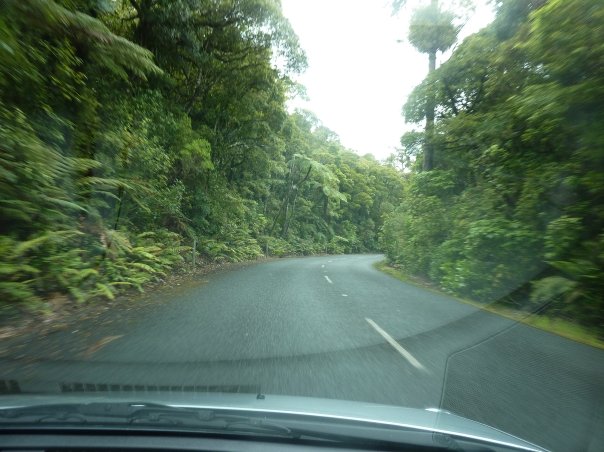 road. The only two alternative roads to Gisborne were the Northern coastal route and the Southern mountain route – either of which would have very scenic but would have taken hours longer.
road. The only two alternative roads to Gisborne were the Northern coastal route and the Southern mountain route – either of which would have very scenic but would have taken hours longer.
Photo: Parts of the road that do not wander along a cliff face are contained within a green curtain of vegetation.
As we moved out of Waioeke, we entered gently rolling hills – home to many sheep and cattle farms. The countryside slowly wound down to lush fertile flatland enroute to Ormond and Gisborne. Here we found row upon row of grapes, citrus and other field crops interspersed with fields reserved for grazing cattle and sheep. The fields were bordered by trees planted and pruned as windbreaks to protect the grape vines and fruit trees from wind damage.
(690)
New Zealand: High Moutain Pass
This shot provides a view of the road on the opposite side of the valley as we proceed around a band. In many places the road clings to the cliff anywhere from 500 to 2000 feet above the Shotover River. Link here for full set of photos.
To the Shotover River Gold Mines
In Queenstown Lynn and I booked for a trip to the Shotover River. This was listed as a “Jet Boat River Ride” but, as it turned out, the real adrenaline rush was the one hour and fifteen minute four wheel drive to reach the river launch site.
For the trip our driver and guide, Craig, a young man who has made this trip dozens of times, was one of those people that truly make a trip special.
I managed to snag the “shot-gun” seat but fifteen minutes after leaving the secondary for the gravel mountain road I was not so sure it was the seat I wanted. Lynn was right behind me in a single seat and if she had a choice I am sure she would have abandoned the trip.
Although I took dozens of pictures (it kept my mind off the drop) it was hard to capture this road in two dimension. I wish I had used the video feature on my camera.
As we wound our way into the moutains we climbed from 500 to 2000 feet on a single lane gravel road that was barely wide enough to negotiate with our four wheel drive bus. In many areas Lynn and I were on the cliff side and you could not see the road below our window. The river would be our first stop if the side suddenly caved away or the driver made a misstep.
You must also remember this is a two way regulard NZ highway (see the road sign photo) with the usual rules – speed 80 km – you’ve got to be kidding. If you meet another vehicle, in most places you cannot pass as the road is only one narrow lane, therefore one vehicle must back up until you reach a section that will allow the pass. As you pass, one vehicle pulls to the cliff edge and the other squeezes by on the cliff side.
Anyone, even a new driver, can take to this road and we heard that on a few occasions drivers simply abandoned the trip as it would take (I am sure) nerves of steel or the fearlessness of youth) to actually drive on this road.
The road continues for what seems forever until we finally wind down into a valley to catch the jet boat for a further ride up the river. The boat ride at high speeds through screaming turns seems positively tame compared to the road trip. On the river we pass the location of the river flood scene in the “Lord of the Rings” and do several high speed 360 degree turns along the route.
Returning from the jet boat, Lynn and I seriously considered catching a “chopper” ride out as it provides regular service for those bus riders who might choose an alternative route out but opted for the bus as we did not want to bail on Craig. Several people from our bus waited for the chopper.
Not wanting to be a seat hog, I checked to see if anyone else might wish to ride shotgun but there were no takers.
Lynn and a couple of the passengers asked me not to talk to the driver (a nervous reaction on my part) as he always choose to look at me when he answered and I suppose they figured he should be watching the road.
Craig tells me that for years he has wanted to become a pilot and while I encouraged him to live his dream, I cannot imagine how flying would provide any greater thrill than taking this bus through that mountain road several times a week.
When we finally reached the paved road the muscles in my legs ached after compressing the floorboards for over an hour.
Lynn was still in a state of shock but I suspect she will now consider a normal paved mountain pass switchback road, like those in Canada, to be rather mundane. I also think she might even consider a parchute jump to be OK as it would be over in less than five minutes.
Shotover River
Queenstown, NZ
2009
(281)
New Zealand: Heading into Queenstown
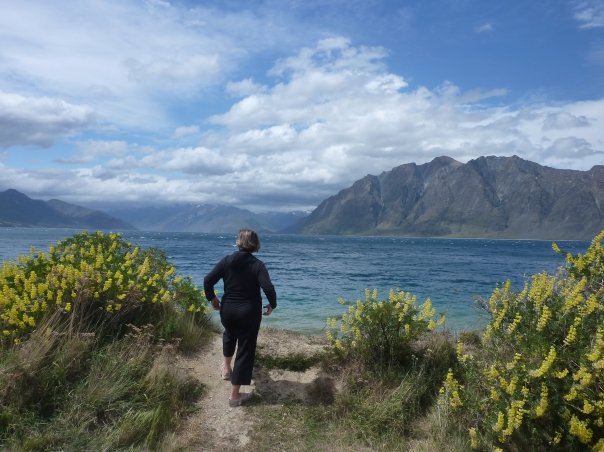
The weather continues to clear and warm as we move inland toward Queenstown. The mountain roads present incredibly beautiful scenes that would rival anything we have seen elsewhere in the world including Canada. While the roads are very good, we must continue to negotiate switchbacks that always take us two kilometers forward and one kilometer back. The nice part of this is that it gives you a chance to see every scene from a 360 degree perspective.
We pass through gold mining towns and sheep stations that provide us with some insight into the challenges faced by early settlers that first moved into this area. I don’t think even the local Maori people even spent much time in many of these areas.
We take a secondary highway through a place called Cardrona and not long thereafter navigate a mountain pass that is reported to be the highest paved road in New Zealand. We stop at a pullout near a lone dead tree and continue on foot, climbing another 500 meters on mountainsides covered with tussock grass. Along the way we pass one small communite called, of all things Athole, another called Bush! Apparently someone loved one of the US Bush boys as they removed Pine from the name.
(296)
New Zealand: To the South Island
Our travels in the North Island have pretty much wrapped up and we are now headed south. The weather turned blustery as we near Wellington and continued for several days through to the Fox Glacier. The ferry was as modern as any we have in British Columbia however the waters through which it travels is subject to severe storms. The ferry crossing was rough as you will note in the photos but we snagged front row seats in the passenger lounge with movie and, if we had wished, alcoholic drink. None of this dampened our spirits as there were so many sites to see.
Once off the ferry, we travelled south along the West Coast on roads that were almost devoid of traffic. Throughout NZ there are hundreds upon hundreds of one way bridges each of which has it’s own personality and the switchbacks on the narrow mountain roads have now become a way of life.
It seems that the north part of the South Island provides challenging life for those who desire to live in that rather remote area. As about 75% of Kiwi’s live in the North Island and the majority of those who live in the South Island occupy the main cities along the more temperate East Coast.
Never-the-less these hearty soles are a most welcoming people and no matter were we stay we always end up meeting people anxious to know more about Canada and Canadians and each of whom are eager to share a bit of their life story.
West Coast, South Island
New Zealand, 2009
Note: Photo (below) comments will be added. It seems they were lost in the blog transfer. hdm
(339)

